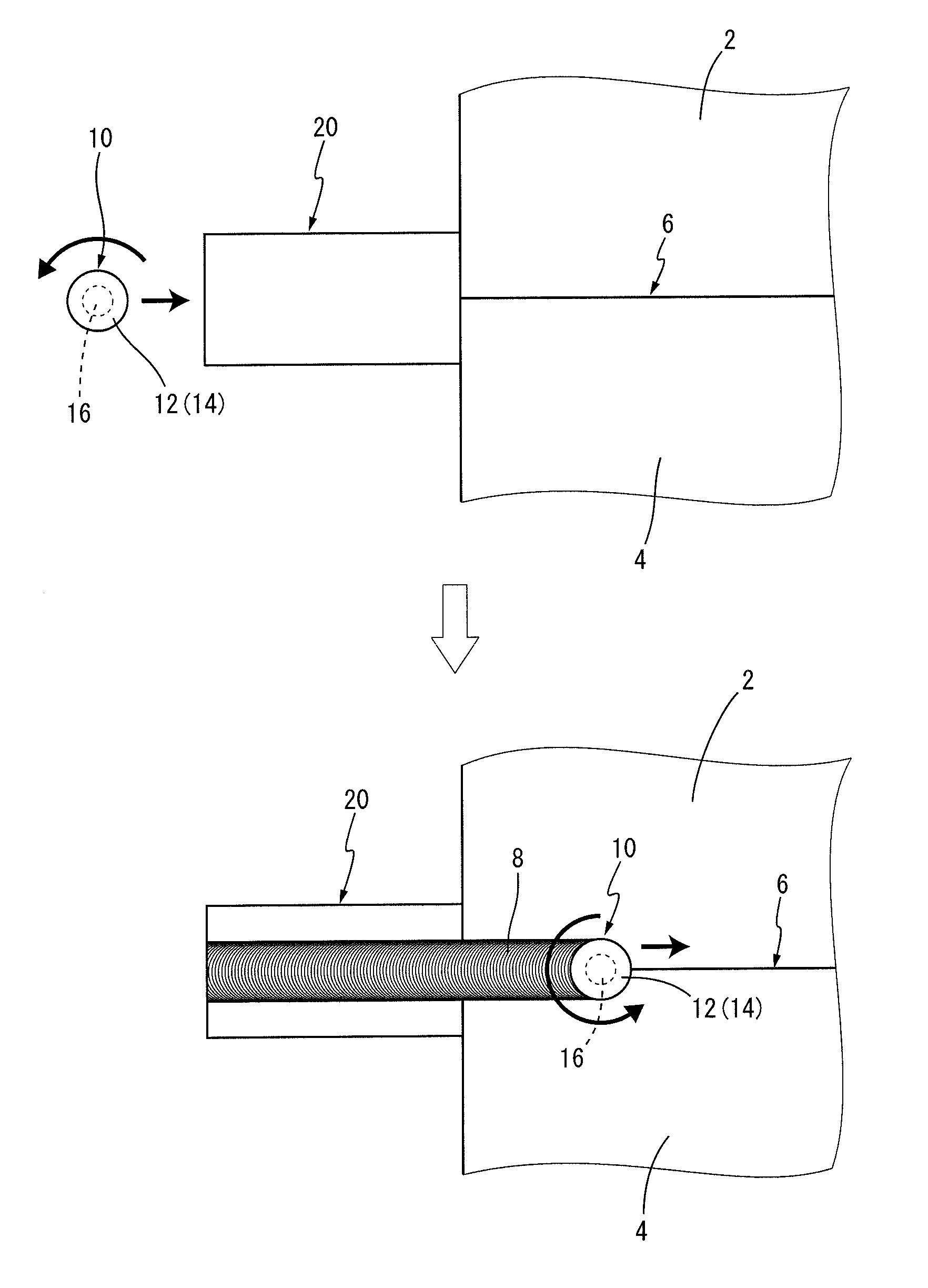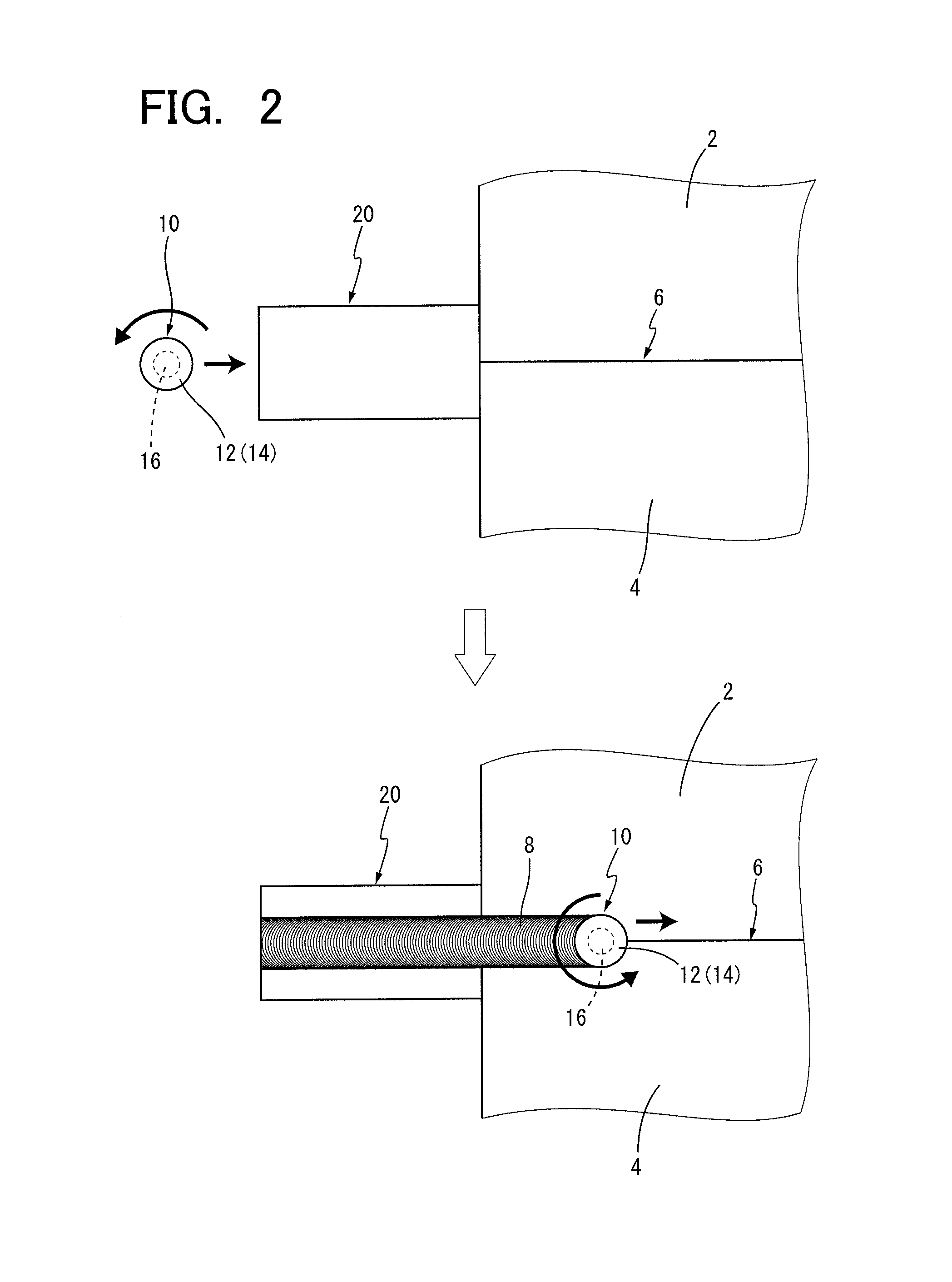Friction stir welding method
a friction stir and welding method technology, applied in welding/soldering/cutting articles, non-electric welding apparatus, manufacturing tools, etc., can solve the problems of failure of joining of hollow members, difficult to use friction stir welding method for joining hollow members, and difficult to be joined together, so as to improve the fluidity of metals, facilitate friction stir, and improve the effect of fluidity
- Summary
- Abstract
- Description
- Claims
- Application Information
AI Technical Summary
Benefits of technology
Problems solved by technology
Method used
Image
Examples
example 1
[0048]A planar first member (2) and a planar second member (4) each of which is formed of one of various aluminum materials indicated in Tables 1 and 2 given below, and has a thickness (t) of 2.8-9.2 mm, a width of 300 mm and a length of 5000 mm were butted on each other at their side faces which are opposed to each other in the direction of their width, to provide an abutting part (6). The first and second members (2, 4) were fixed on a table having a gap provided so as to be located below the abutting part (6) of the two members (2, 4). A planar initiation tab member (20) which is formed of one of various aluminum materials indicated in Tables 1 and 2 and has a thickness (Ts), a length (Ls) in a welding direction and a width (Ws) in a direction perpendicular to the welding direction, as indicated in Tables 1 and 2, was held in abutting contact with an end portion of the abutting part (6) of the two members (2, 4) on the side of initiation of a welding operation, as shown in FIG. 1...
example 2
[0053]A first member (2) and a second member (4) each of which is a rolled sheet formed of an aluminum material: 5454-O, and has a thickness (t) of 4.0 mm, a width of 300 mm and a length of 5000 mm were butted on each other in the direction of their width, to provide an abutting part (6). The first and second members (2, 4) were fixed on a table having a gap provided so as to be located below the abutting part (6) of the two members (2, 4). An initiation tab member (20) which is formed of an aluminum material: 1200 and has a thickness (Ts) of 4.0 mm, a length (Ls) in a welding direction and a width (Ws) in a direction perpendicular to the welding direction, as indicated in Table 3 given below, was abutted on an end portion of the abutting part (6) of the two members (2, 4) on the side of initiation of the welding operation, and fixed on the table, like the two members (2, 4).
[0054]A friction stir welding operation was performed as in the Example 1, by using, as a rotary tool, a bobb...
example 3
[0056]A planar termination tab member (22) which is formed of one of various aluminum materials indicated in Tables 4 and 5 given below, and which has a length (Le) in the welding direction, a width (We) in a direction perpendicular to the welding direction and a thickness (Te), as indicated in Tables 4 and 5, was held in abutting contact with end faces of the two planar members (2, 4) in the abutting part (6) on the side of termination of the welding operation. The friction stir welding operation was started as in the FSW Examples 1-20 of the Example 1, and terminated by moving the bobbin tool (10) that had been moved across the abutting part (6) in the longitudinal direction thereof, into the termination tab member (22) from the terminal end of the abutting part (6), and moving the bobbin tool (10) through the termination tab member (22) in the welding direction, as shown in FIG. 4. When the friction stir welding operation was terminated as described above, the bobbin tool (10) wa...
PUM
| Property | Measurement | Unit |
|---|---|---|
| diameter | aaaaa | aaaaa |
| thickness | aaaaa | aaaaa |
| thickness | aaaaa | aaaaa |
Abstract
Description
Claims
Application Information
 Login to View More
Login to View More - R&D
- Intellectual Property
- Life Sciences
- Materials
- Tech Scout
- Unparalleled Data Quality
- Higher Quality Content
- 60% Fewer Hallucinations
Browse by: Latest US Patents, China's latest patents, Technical Efficacy Thesaurus, Application Domain, Technology Topic, Popular Technical Reports.
© 2025 PatSnap. All rights reserved.Legal|Privacy policy|Modern Slavery Act Transparency Statement|Sitemap|About US| Contact US: help@patsnap.com



